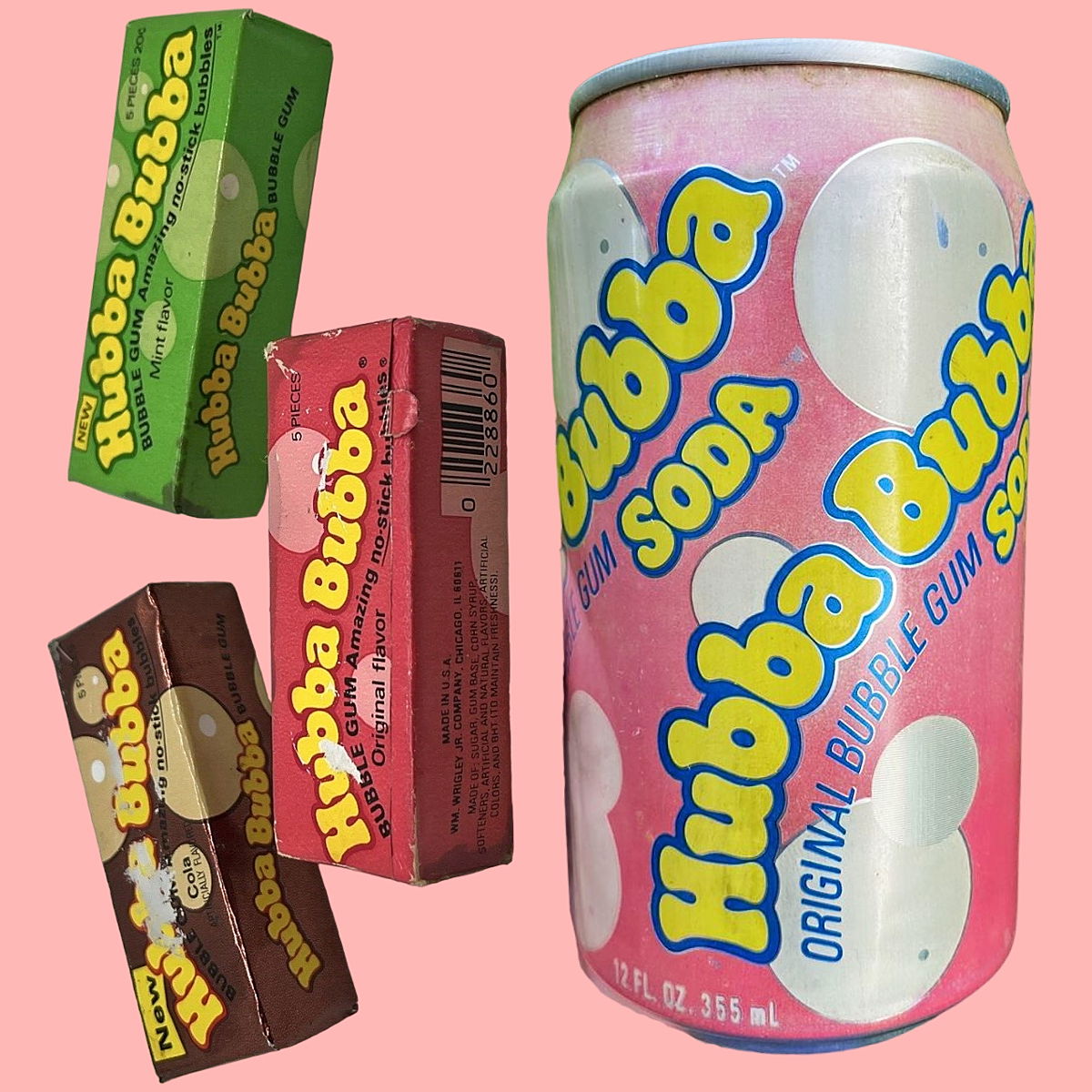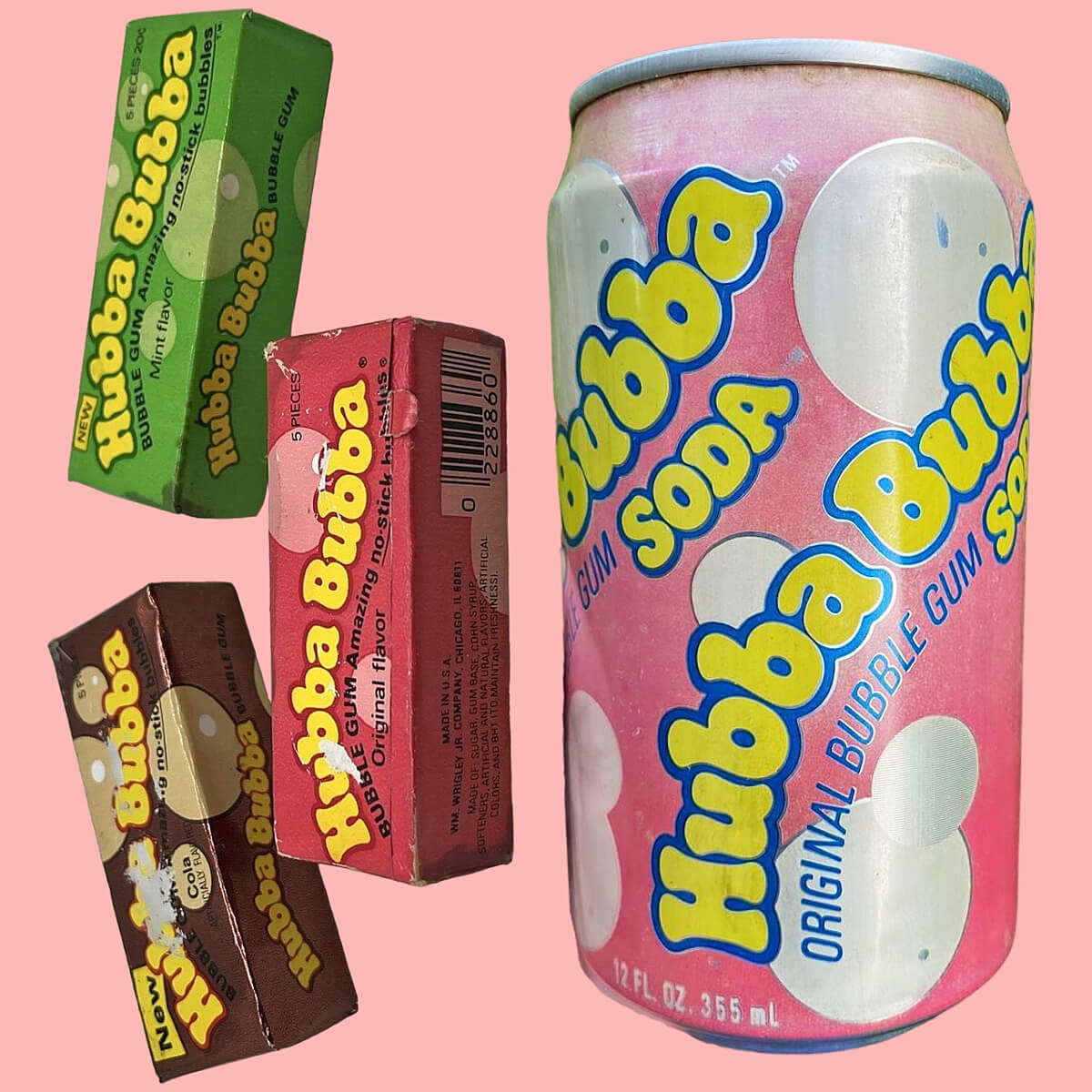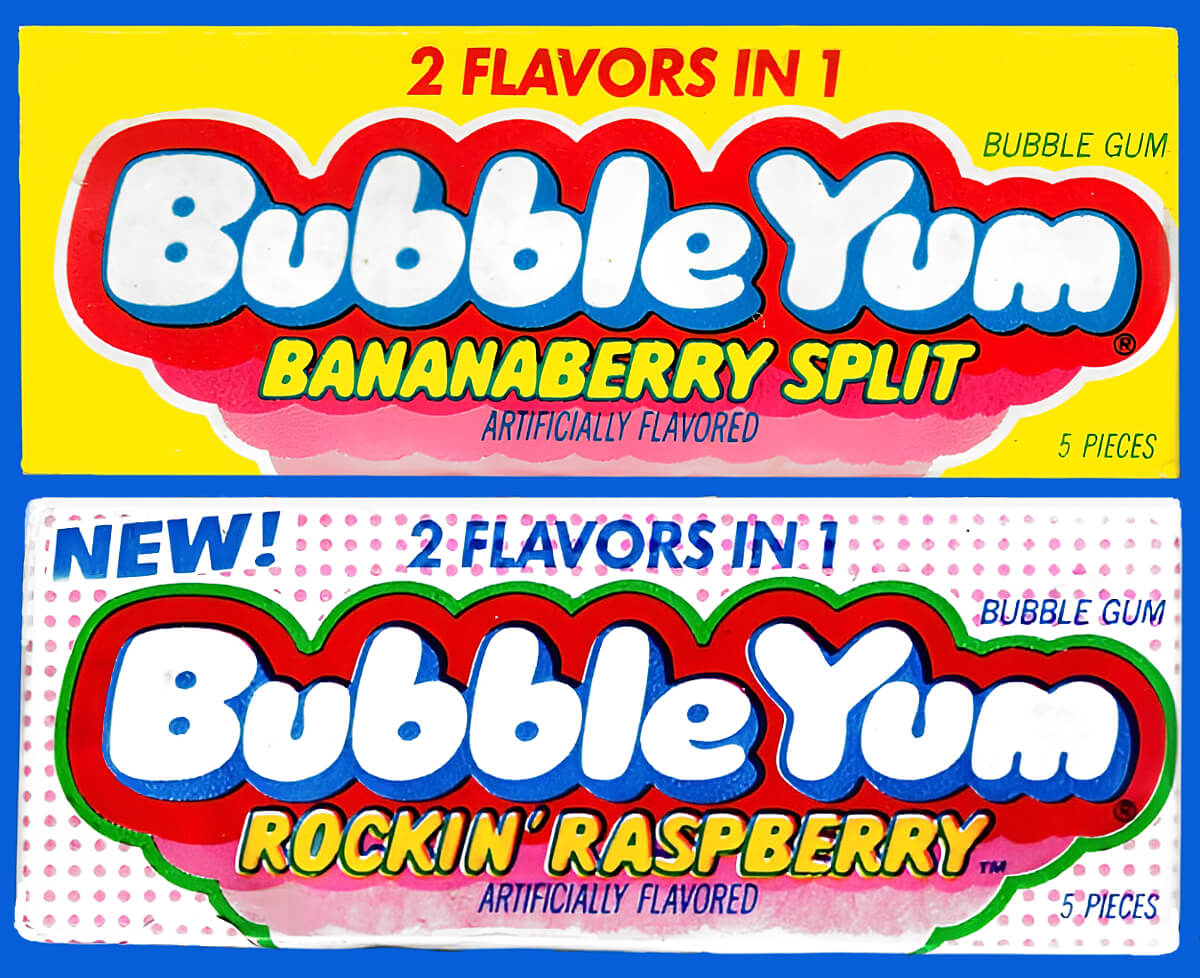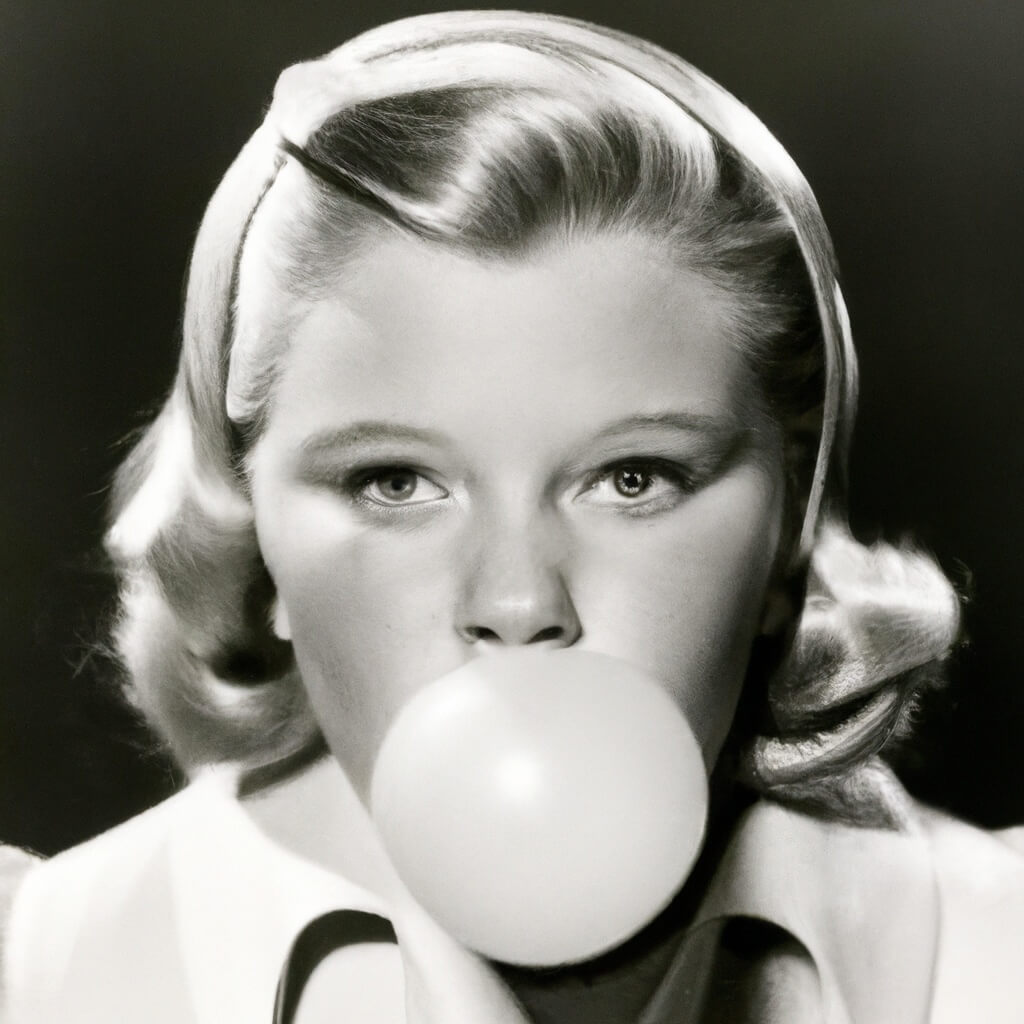The History of Bubblegum: Chewing Through Time

Bubblegum, with its vibrant colours, irresistible fruitiness, and the promise of endless bubbles, has been a beloved treat for over 90 years, and continues to captivate people around the world.
Whether you're a child blowing your first bubble or an adult indulging in a sweet nostalgic moment, the sticky delight of bubblegum remains a simple pleasure that brings joy and smiles to faces across generations.
So join me, as I delve into the fascinating history of bubblegum, revealing the story behind its inventor, its cultural significance, and the brands that became popular during the 20th century.

Hubba Bubba bubblegum (Cola, Mint and Original) and soda can from the 1980s
Who invented bubblegum?
Bubblegum was invented by Walter E. Diemer in 1928. He was an accountant at the American confectionary company Fleer, and was testing out new recipes for chewing gum using "Blibber-Blubber", a formulation that had previously been developed by Frank H. Fleer in 1906.
The formula was basically a stretchy version of chewing gum but was problematic, and up to this point, had never been used due to its brittle texture and the fact that it was incredibly difficult to remove from the face after the bubble had burst. Diemer solved the problem by adding latex to the formula, and Fleer named it Dubble Bubble, which became the very first brand of bubblegum.
Why is bubblegum pink?
Its inventor, Walter E. Diemer, wanted his new bubblegum product to be a different colour than regular chewing gum, and his recipe produced an unappetising, murky grey colour. The only colourant available in the Fleer factory was a red food colouring, so he diluted it to become pink, and added this to his first batch of 100 bubblegum pieces, which he then displayed at a local sweet shop (candy store), which sold out the same day.
The pink gum recipe was used by Fleer for the first commercial production of its new Dubble Bubble, and it became the standard colour for bubblegum across the globe. Today, the association between bubblegum and the colour pink is so strong, that many people automatically envision a pink bubble when thinking about chewing gum.
Of course, bubblegum has seen an evolution in flavours and colours since its early years, and now comes in many exiting new varieties, such as blue raspberry, strawberry, tutti frutti and even watermelon.
Disclosure: This page contains affiliate links. As an Amazon Associate, I earn from qualifying purchases.
Popular bubblegum brands
Anglo Bubbly
If there is one bubblegum that everyone remembers from their UK childhood, then it has to be Anglo Bubbly, which is, in my opinion, the king of all bubblegum. Anglo Bubbly was introduced to the UK in 1932 by the British confectioner Barratt. With its iconic yellow, pink and blue wrapper and the classic slogan "Blows bigger bubbles", the vintage pear-flavoured bubblegum certainly has a nostalgic and retro appeal.
During the 1960s, 70s and 80s, Anglo Bubbly was particularly popular, as it was so widely available, being sold loose as a penny sweet in many sweetshops across the UK, and also as part of Woolworth's Pick 'n' Mix selection.

Bazooka bubblegum wax wrapper ft. Bazooka Joe comic strip, with pin badge, both from the 1970s.
Bazooka
Bazooka was the first new bubblegum to be launched after World War II. It was introduced to the U.S. market in 1947, and came in patriotic red, white and blue packaging. It soon made its way to the UK and other countries, and in 1953, The Topps Company Inc. introduced a new comic strip wax wrapper featuring the character Bazooka Joe.
The brand is still available to buy today, and the wrapper colours and logo have remained pretty much the same.
Bubble Yum
In 1975, Life Savers launched a new soft bubblegum called Bubble Yum, and it was advertised by a young Leonardo DiCaprio during the 1980s. It soon became the leading brand in the U.S., and remains so today. It's also available to buy in the UK.
The brand was sold to Nabisco in 1981, with The Hershey Company taking over in 2000.
Past flavours have included Bananaberry Split, Checker Mint, Wild Cherry, Tropical Punch, Rockin' Raspberry, Orange, Luscious Lime and Spearmint. Current flavours are Original, Cotton Candy and Grape, and there is also a lip balm.

Bubble Yum wrappers from the 1980s
Bubblicious
Bubblicious launched in 1977 as a rival to Bubble Yum, and the first flavour was Lightning Lemonade. Although sales were slow in the first year, after a successful "Ultimate Bubble" ad campaign in 1978, sales vastly improved, and the brand became global.
Popular flavours in the past have included Cotton Candy (candy floss), Grape and Sour Cherry, and today you can buy Strawberry Splash, Watermelon, Cola and Ultimate Original.
Dubble Bubble
The first commercially available bubble gum, which launched in 1928 and became the leading brand in the U.S. for two decades before the second world war. However, after World War II, new brands started to enter the market. See "Who invented bubblegum" below. The brand is also famous for its fruit-flavoured gum balls, and the original flavour can still be bought today.

A vintage Dubble Bubble Gum cardboard counter display box from the 1950s
Hubba Bubba
In 1979, yet another new bubblegum brand entered the market. Hubba Bubba by Mars Inc. was different in that it was less sticky than other brands and could easily be removed from the skin. The brand became popular in both the U.S. and UK, although it was discontinued in the U.S. early on in the 1990s but was relaunched in 2004.
A sticky problem
There is also a negative side to bubblegum. While it has enjoyed immense success, it hasn't been without its challenges. Back in the 20th century, disgusting lumps of discarded sticky pink gum could often be found stuck underneath school desks, stuck to the walls of public lavatories, or worse still, stuck to the sole of your shoe.
Manufacturers have since developed innovations such as sugar-free and non-stick formulations, ensuring that bubblegum remains a convenient and enjoyable treat for all.
In October 2010, Chemistry World released a report "Non-stick chewing gum hits the market", which stated that a brand new, non-stick chewing gum was being launched by Revolymer, which could easily be removed from most surfaces.
Hubba Bubba TV advert from 1988
Where is bubblegum banned?
The sale of chewing gum (including bubble gum) in Singapore has been illegal since 1992, and has many laws against littering and graffiti and spitting. However, you can still use dental and nicotine gums here, as long as they are prescribed by a doctor.
In other countries, bubblegum has been banned in some schools, towns and public places, including the UK, although the UK does not have a nationwide ban.
On March 8, 2013, the Daily Mail reported that Milton Keynes was to become the first town in the Britain to ban chewing gum.
Plastic in chewing gum
There are many consumers who do not realise that one ingredient in chewing gum is “gum base“, which is made out of plastic and contains polyvinyl acetate. On 3rd April 2023, Circular Online reported that 75% of British consumers support a ban on plastic chewing gum
Bubblegum in popular culture
Bubblegum has not only found a place in our mouths but has also made its way into popular culture. It has become a symbol of carefree enjoyment, often associated with childhood and nostalgia. Its presence in movies, TV shows, and music videos reinforces its status as a cultural icon. Who could forget the iconic bubblegum-popping scenes in the classic 70s film Grease, for instance, and there is even a genre of music called bubblegum pop.
Bubble blowing competitions
Many adults will have childhood memories of school playground contests, in which kids would compete with each other to blow the biggest bubble. And yes, there was always one child who had the gift of creating a bubble that seemed to defy the rules of science, perfecting a bubble that was larger than their own head! But, of course, equally satisfying is popping the bubble afterwards.
After unwrapping the plump disc of retro pink bubblegum, I could never quite master the art of bubblegum blowing. Indeed, my own attempts were usually pretty feeble, but I did enjoy the fruity flavour, at least!
World record
Some people take their bubble blowing to the next level by trying to break the world record. The Guinness record holder for blowing the largest bubblegum bubble is Chad Fell from the U.S. He achieved this in 2004, by chewing on three double bubblegums, and blew a bubble that was just over 50cm in diameter.

I hope that you enjoyed delving into the history of bubblegum. Also check out our post 60 Classic Retro Sweets You Can Still Buy Today
